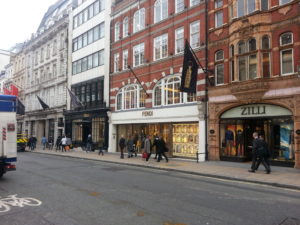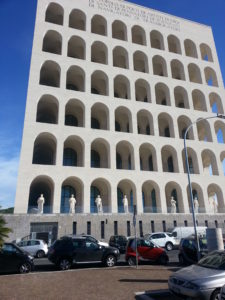
Yet another Fendi, Bond Street this time
With all the hoopla associated with the sale of the grotesque and shall we say authentically arguable Salvador Mundi, one would assume the major auction houses are a beehive of activity. All I can say is, you couldn’t prove it by me.
But then, virtual activity is very much harder to gauge. We attended a sale at Sotheby’s Bond Street a couple of weeks ago, and the sale room complement consisted of an auctioneer on the podium, and half a dozen associates fielding a bank of phones, and, wait for it, four people- including myself- bidding in the room. Mind you, there were an unknown number of bidders signed on to participate virtually, which must have done the trick overall, as the lots in the sale were pretty generally taken up.
For myself, nothing substitutes for bidding in the room. One can achieve a sense of interest in the material offered, and as a prospective buyer, one can also gauge the competition and if it might be intense, one can then back away, and not risk becoming infected with auction fever.
Or so it was. Now of course, with no one in the room, and all the activity virtual, what was to my mind an exciting activity has now become something very sterile. As indeed, all of Bond Street has become. Gone are very nearly all the independent merchants, and even Sotheby’s has sublet a significant portion of its leasehold to others, witness the presence of a pair of leasing agents while we were there, discussing space availability with a couple of prospective tenants.

Fendi in EUR
I can’t help but put forth a photo showing Fendi, opposite Sotheby’s, now occupying Mallett’s old space, and one has to wonder how many Fendi outlets are actually required, in London or anywhere else. But then, international luxury branding has and continues to roll forward inexorably, continuing to displace what had made London’s Bond Street one of the pillars of the international art market. As I think about it, luxury mass market giant LVMH has very nearly taken over Bond Street, with profound prominence throughout the West End and nearby Knightsbridge, with other Fendi outlets, as well as Chanel, Givenchy, and Louis Vuitton.
The concentration of an enormous amount of capital in corporate hands has materially changed Bond Street, as it has so many other commercial venues internationally, in a nearly fascistic control of even luxury consumerism. It seems appropriate, therefore, that Fendi should have its headquarters in the Mussolini commissioned Palazzo della Civilta Italiana, placed prominently in the dictator’s master planned EUR, outside central Rome.
